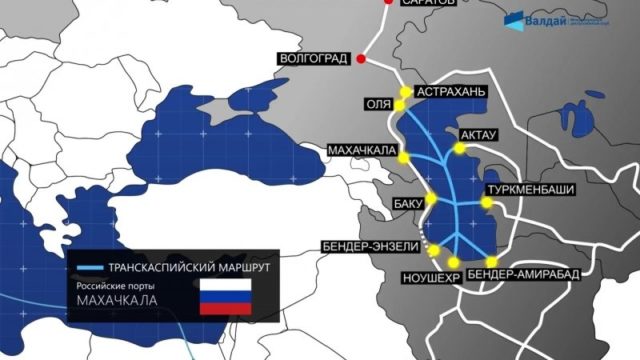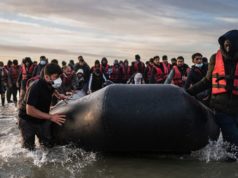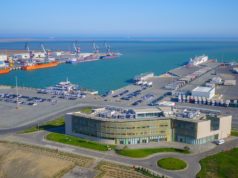The first freight train arrived from Russia to Iran from the territory of Turkmenistan. It traveled 1,600 km along the Eastern Chord of the North-South International Transport Corridor (ITC) heading to the Iranian port of Bandar Abbas.
Departing from the Chekhov station near Moscow, the train with 39 containers traveled 3,800 km along the railways of Russia, Kazakhstan and Turkmenistan and arrived in Iran at the Serakhs railway station in the Khorasan-Rezavi province on the border with Turkmenistan. The train will reach the port of Shahid-Rajai in the province of Hormozgan in southern Iran, then the cargo will be delivered by sea to India.
The main advantage of the ITC “North-South” over other routes, in particular over the sea route through the Suez Canal, is a more than twofold reduction in the distance of transportation and a reduction in their cost.

On March 23, 2021, the container ship Ever Given blocked the Suez Canal for a whole week , resulting in a loss of about $30 billion for 400 ships. In early April, the threat of blocking the Suez Canal was again created by the aground tanker Minerva Nike . The credibility of this waterway has been undermined, and the search for an alternative to the Suez Canal has become particularly relevant.
One of the possible alternatives to Suez is the North-South ITC.
The story originates in the Russian Empire, where in 1910 a project was developed for the navigable canal from the Caspian Sea to the Persian Gulf. In the 1970s Soviet and Iranian specialists resumed work on this project, but failed to implement it.
At the beginning of the 21st century, Russia began to actively establish a strategic partnership with the countries of the Caspian Sea. After the collapse of the USSR, this pivotal region of Eurasia became the object of claims by extra-regional forces, primarily the United States. Since 1994, the provision on the Caspian as a zone of national interests and energy security of the United States has been repeatedly included in the National Security Strategy of the United States. A number of large American oil and gas companies ( Chevron, ExxonMobil , etc.) have started developing the Caspian natural resources.
In 1997, the United States, fearing the weakening of its influence in the Caspian region, imposed sanctions against the construction project of the Caspian-Persian Gulf canal.
At the turn of the century, the Russian government took the initiative to build a 7,200-kilometer North-South international trade route. It involved the construction of highways from the coast of the Arabian Sea (the port of Mumbai in India) and the Persian Gulf (the Iranian port of Bandar Abbas) to the Iranian coast of the Caspian Sea. From there, transportation was planned to be carried out either by sea or by land through the Russian Caspian Sea with access to the railway to St. Petersburg.
The Russian initiative received the support of India and Iran. On September 12, 2000, during the work of the 2nd International Eurasian Conference on Transport in St. Petersburg, the governments of the three countries signed an Agreement on the International Transport Corridor “North – South” – “from India, Oman by sea, through Iran, the Caspian region, the Russian Federation and so on in the opposite direction .
In May 2002, the ministers of transport of the countries participating in the Agreement signed a protocol on the official opening of the North-South ITC. In subsequent years, Azerbaijan, Armenia, Belarus, Kazakhstan, Kyrgyzstan, Syria, Turkmenistan, Turkey and Bulgaria (as an observer) joined the project.
In the future, it is possible to join the ITC “North – South” of the Trans-Arabian Railway, connecting Saudi Arabia, Bahrain, Kuwait, Qatar, the United Arab Emirates and Oman. This would make it possible to bring international trade routes beyond the boundaries of continental Eurasia.
If the delivery of goods from India to Western Europe via the Suez Canal takes from 25 to 38 days, then along the ITC “North-South” the same cargo can reach its destination in 15-18 days, while the cost of freight transportation is reduced by 30-40% .
In addition to the Eastern Expressway, which connects Russia with India through the countries of Central Asia – Kazakhstan, Uzbekistan and Turkmenistan, it is planned to launch two more branches.

The central branch starts in the largest Indian port Jawaharlal Nehru in the suburbs of Mumbai in the state of Maharashtra on the coast of the Indian Ocean. It then connects by a 1275 km long sea route to the port of Bandar Abbas in the Strait of Hormuz and passes to the north of Iran by road and rail to the Caspian port of Anzali , where it can continue to the ports of Lagan and Astrakhan in Russia, as well as ports in Azerbaijan , Turkmenistan and Kazakhstan .
The western line connects the railway network of Azerbaijan with Iran through the cross-border hubs of Astara (Azerbaijan) and Astara (Iran) by sea to the port of Jawaharlal Nehru in India.
The main product categories of the North-South ITC suitable for containerization are food (21.2%), metals (16.6%), wood and paper (9.5%), machinery and equipment (8.3%) , mineral fertilizers (4.9%). According to the calculations of analysts of the Eurasian Development Bank (EDB), it is expected that by 2030 the total potential of freight traffic along the ITC will reach 14-24 million tons.

The unique meridional direction of the North-South ITC creates opportunities for docking with latitudinal transport corridors running from East to West, which makes it possible to create a Eurasian transport framework – a network of interconnected transport corridors in the East-West and North-South directions. “This will help reduce export costs, create the potential for new production niches, and realize the region’s transit potential. Due to the fact that the Eurasian Transport Framework “reaches out” to China, India and the European Union, it can act as a material basis for the implementation of the idea of Greater Eurasia ,” said Evgeny Vinokurov, Chief Economist of the EDB.
The advantages of the ITC “North – South” will become even greater after the completion of the construction of the 165-kilometer section of the railway “Rasht – Astara” in Iran. In early 2022, during a visit to the Caspian province of Gilan, Iranian President Ebrahim Raisi said: “The North-South corridor, the last segment of which is the construction of the Rasht-Astara railway, will provide Iran with significant economic benefits and will contribute to the development of our relations with neighboring countries.”
Initially, it was assumed that the ITC “North – South” through Russia and the Caspian region will connect the Baltic countries and India. “However, in conditions when Europe has closed, the new corridor is becoming one of the main routes for the delivery of goods to our country, ” explained Vladimir Evseev, director of the sector of the Institute of CIS Countries.
source: https://www.fondsk.ru/news/2022/07/15/kogda-evropa-zakrylas-56696.html







